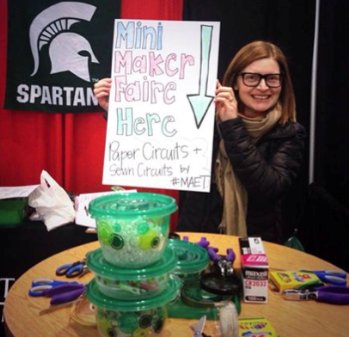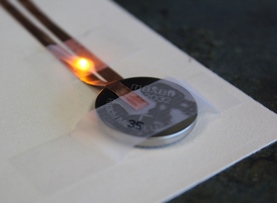On the surface, the Maker Movement with its focus on 3-D printing, hands-on craftsmanship, and industrial design may not seem an especially good “fit” for the English Language Arts (ELA) classroom. The ELA teachers I meet generally acknowledge Science, Technology, Engineering and Math (STEM) as important, but wonder how they can integrate STEM principles into writers’ workshop or literature circles.
 As our colleagues in science and the technical subjects learn to teach literacies to meet Common Core State Standards expectations, I see the integration of electric circuits in ELA, inspired by the Maker Movement, as interdisciplinary reciprocity. In my view, this activity can support the integration of ideas across content areas and build problem solving skills. I also learned that it can be a lot of fun. In what follows, I explain.
As our colleagues in science and the technical subjects learn to teach literacies to meet Common Core State Standards expectations, I see the integration of electric circuits in ELA, inspired by the Maker Movement, as interdisciplinary reciprocity. In my view, this activity can support the integration of ideas across content areas and build problem solving skills. I also learned that it can be a lot of fun. In what follows, I explain.
Last week, I co-hosted a Mini Maker Faire at the Michigan Association of Computer Users in Learning (MACUL) conference with my MSU Colleagues. The response from teachers was so positive that I wanted to share what we learned with the TILE-SIG Community.
We invited conference attendees to make a wearable electrical circuit using inexpensive and easily available materials. Inspired by the work of Jie Qi, the high-low tech team at the MIT Media Lab, and the work of Exploratorium, we wanted to push teachers’ notions of “technology integration” and highlight the potential of maker activities for interdisciplinary learning.
Activity #1 invited people to add an LED light to their conference name badge using copper tape, a coin battery, and scotch tape. Activity #2 invited people to sew an LED light into a felt badge using conductive thread, and a coin battery. Step-by-step instructions and lists of materials with links can be found at our program blog. I think TILE-SIG members can leverage two important insights from our Maker Faire experiment.
 Firstly, light can be used to communicate meaning. To me, this opens infinite possibilities for connections to the ELA classroom. Teachers could ask students to draw a picture that integrates an electric circuit with light, strategically placed, to emphasize an especially poignant action, character trait, or feature of the landscape in a novel. Students could write (digitally?) about the meaning they have conveyed in their art, why they made this choice, and how it was inspired by their reading. Alternatively, students could create a video of themselves describing the meaning in their electric art and share it via YouTube. They could also explore or respond to meaning in their classmates’ circuits during a multimodal writers’ workshop. Younger children could practice writing how-to texts to explain how they made the LED light shine. In this way, this multimodal ELA project becomes the week’s science project too.
Firstly, light can be used to communicate meaning. To me, this opens infinite possibilities for connections to the ELA classroom. Teachers could ask students to draw a picture that integrates an electric circuit with light, strategically placed, to emphasize an especially poignant action, character trait, or feature of the landscape in a novel. Students could write (digitally?) about the meaning they have conveyed in their art, why they made this choice, and how it was inspired by their reading. Alternatively, students could create a video of themselves describing the meaning in their electric art and share it via YouTube. They could also explore or respond to meaning in their classmates’ circuits during a multimodal writers’ workshop. Younger children could practice writing how-to texts to explain how they made the LED light shine. In this way, this multimodal ELA project becomes the week’s science project too.
Secondly, these activities generated a lot of smiles. Two hundred colleagues made a wearable electric circuit with us last week and every one of them smiled when their LED lit up. Every participant said “that was cool,” or “I’m going to do this with my students.” The first principle of any project-based learning is authentic engagement. If electricity can put smiles on our students’ faces, they will be more likely to persist in the face of challenge, more likely to care about the learning, and more likely to take risks in any discipline, ELA included.
In sum, I see the integration of simple electric circuits into ELA classrooms as an engaging way to bring science and language arts curricula together for students of any age and I encourage TILE-SIG members to give it a try! If you do, please let me know how it goes!
For more information on the Maker Movement and DIY project ideas: http://makezine.com/
For more curricular connections ideas, see the embedded .pdfs for
Social Studies,
ELA,
Visual Art and
Any Discipline at our
blog post.
TILE-SIG will host a special session on Sunday, May 11 at 3:00 p.m. at the International Reading Association 59th Annual Conference in New Orleans. The session includes the presentation of the 2014 Technology in Reading Research Award, "Changing the Landscape of Literacy Teacher Education: Innovations with Generative Technology" with keynote Dana Grisham (National University, TILE-SIG 2013 Reading Research Award Winner), and 18 roundtable discussions about research findings and practical classroom ideas. Visit http://www.iraconference.org to learn more about IRA 2014 or to register.
Michelle Schira Hagerman directs the Graduate Certificate Programs in Educational Technology and Online Teaching and Learning at Michigan State University.